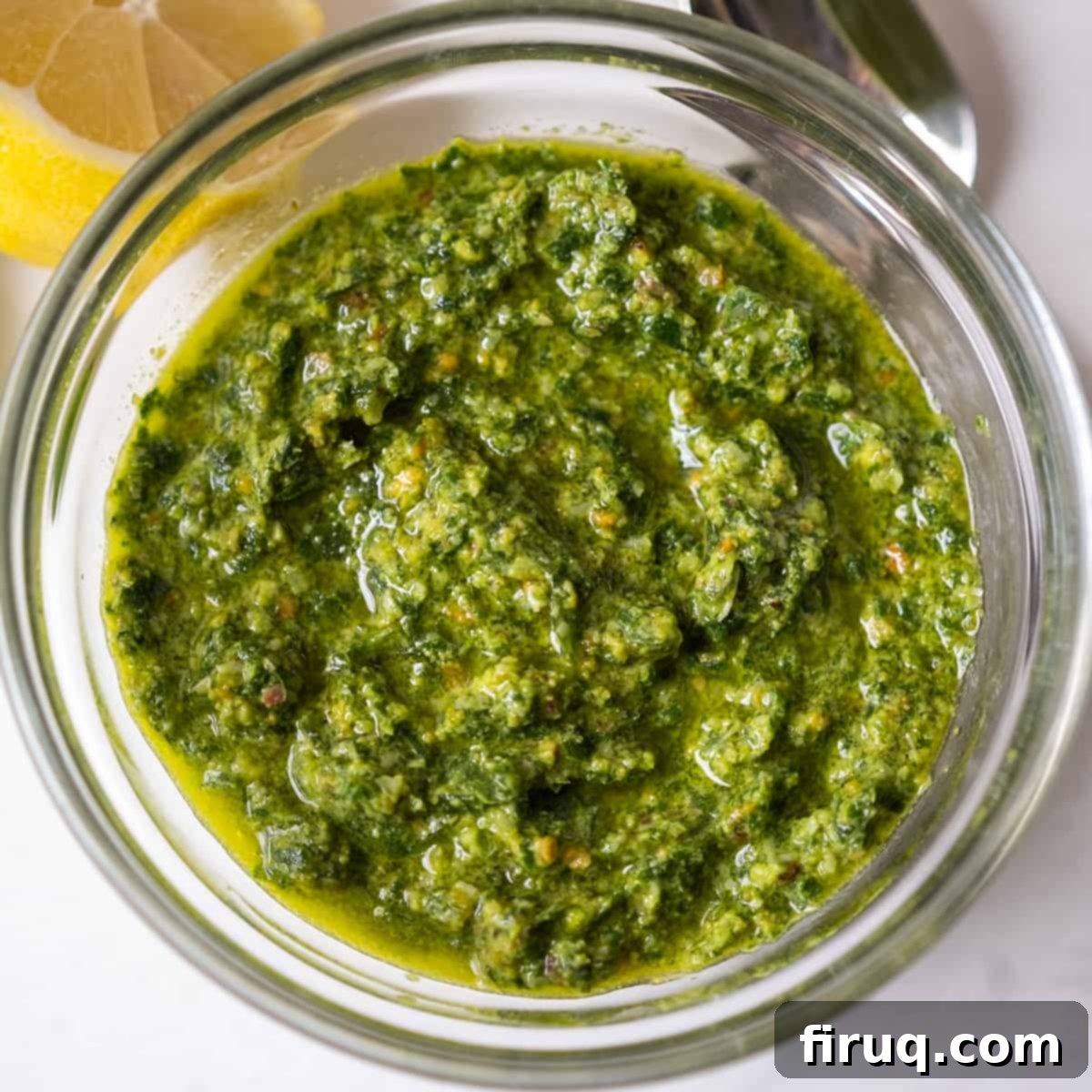Homemade Pistachio Pesto Recipe: A Unique & Flavorful Twist on Classic Italian Sauce
Prepare to elevate your culinary game with this exquisite Pistachio Pesto! While traditional Genovese pesto holds a special place in our hearts, this pistachio-infused version introduces a delightful twist that is equally simple to make, incredibly flavorful, and often more budget-friendly than its pine nut counterpart. Its vibrant green hue and rich, subtly sweet, and earthy flavor profile will make it an instant favorite.
This versatile sauce is perfect for adding a gourmet touch to countless dishes. Imagine spreading a generous dollop on crispy Italian Chicken Cutlets, or swirling it into your pasta when you’re making a hearty Sunday Sauce to infuse your meals with an extra layer of authentic Italian flavor. Its creamy texture and nutty aroma are simply irresistible.
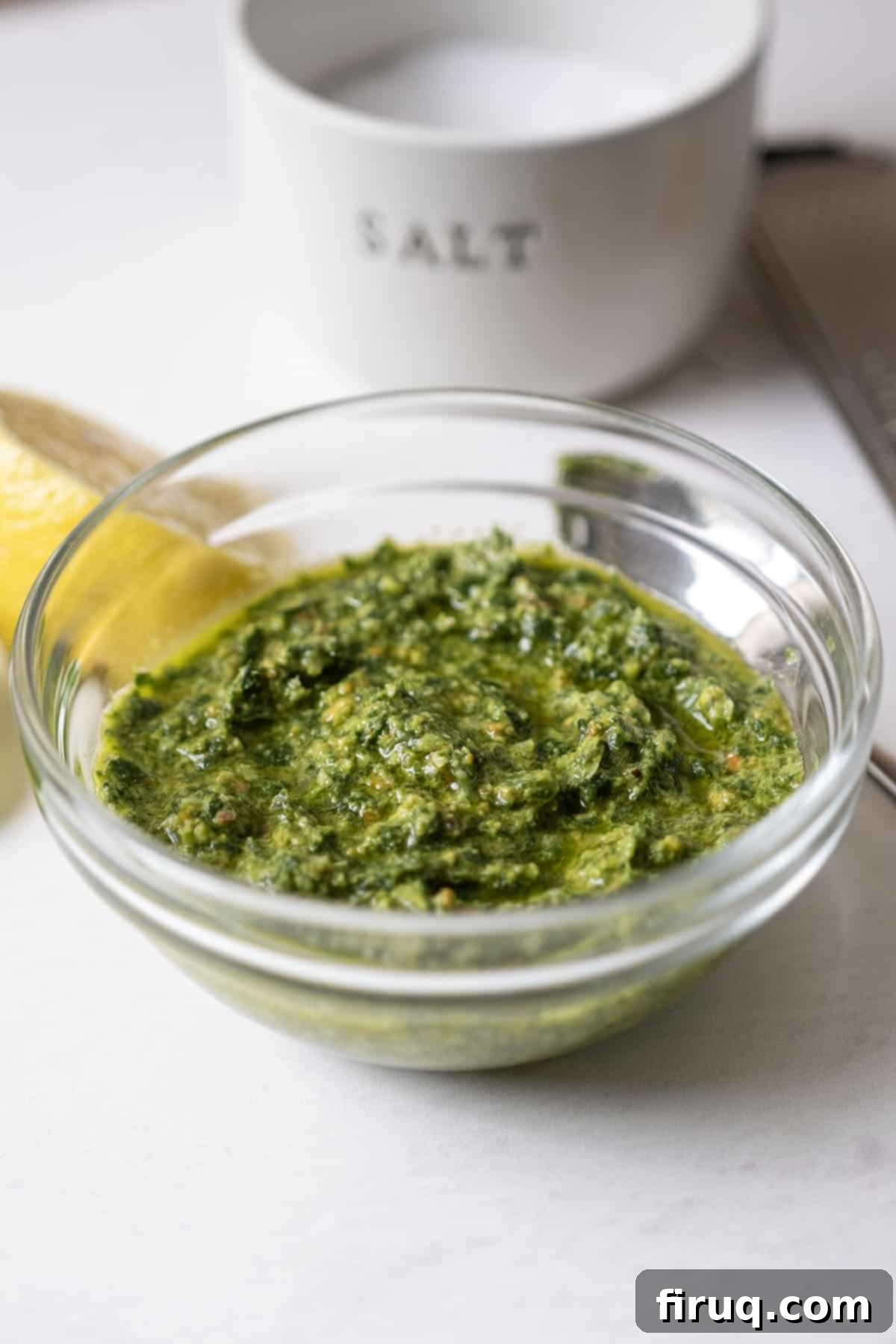
Beyond pasta and chicken, our pistachio pesto beautifully complements a wide array of your favorite meals. Consider pairing it with a rich Italian Pink Sauce with Sausage for an unforgettable dinner, using it as a vibrant counterpoint to Pasta alla Norma (A Sicilian Dish), or even adding a zesty kick to your morning with An Italian Breakfast Sandwich. The possibilities are truly endless!
[feast_advanced_jump_to]
The Diverse World of Pesto: Beyond Genovese
When most people hear the word “pesto,” their minds immediately conjure images of the classic bright green sauce from Genoa, Italy – a rich blend of fresh basil, pine nuts, garlic, Parmigiano-Reggiano, and olive oil. However, the world of pesto is far more expansive and fascinating than many realize. The term “pesto” itself comes from the Italian word “pestare,” meaning “to crush” or “to pound,” referring to the traditional method of preparation using a mortar and pestle. This highlights that any sauce made by crushing ingredients can, in a broader sense, be considered a pesto.
Indeed, there are numerous regional variations across Italy and beyond. For instance, in Sicily, you’ll find Trapanese pesto (Pesto alla Trapanese), which brilliantly incorporates fresh tomatoes, almonds, and Pecorino cheese alongside basil and garlic, offering a lighter, tangier profile. And for those moments when fresh basil might be scarce, creative cooks have even developed pea pesto, substituting peas for basil to achieve a similar verdant color and sweet, fresh flavor. These variations prove that pesto is not just a single recipe but a versatile concept, adapting to local ingredients and culinary traditions.
Our featured recipe, pistachio pesto, is a fantastic example of this adaptability. The primary difference between a classic Genovese pesto and this one lies in the choice of nuts. By swapping pine nuts for pistachios, we unlock a new dimension of flavor and texture. Pistachios lend a slightly sweeter, earthier, and richer note, creating a pesto that is both familiar and excitingly different. This pesto shines when tossed with your favorite pasta or served over succulent Classic Italian Fried Meatballs, adding a gourmet touch to any meal.
Why Pistachios? A Nutty Twist on Tradition
Choosing pistachios for pesto isn’t just a random substitution; it’s a deliberate choice that brings distinct advantages. Pistachios, with their beautiful green hue, already mimic the color of basil, ensuring your pesto looks as appealing as it tastes. Flavor-wise, they offer a slightly sweeter and more pronounced nutty flavor than the milder pine nuts. This unique profile can elevate dishes, providing a sophisticated backdrop for the fresh basil and garlic.
From a practical standpoint, pistachios can also be a more cost-effective option than pine nuts, which are often among the most expensive nuts on the market. This makes pistachio pesto a delicious and accessible gourmet experience that doesn’t break the bank. Plus, for those with pine nut allergies or simply looking to try something new, pistachios offer a fantastic and equally satisfying alternative.
Ingredient Notes and Substitutions for Perfect Pistachio Pesto
Crafting exceptional pesto relies on fresh, high-quality ingredients. Each component plays a crucial role in achieving the perfect balance of flavor, aroma, and texture. Here’s a closer look at what you’ll need and how to make the best choices:
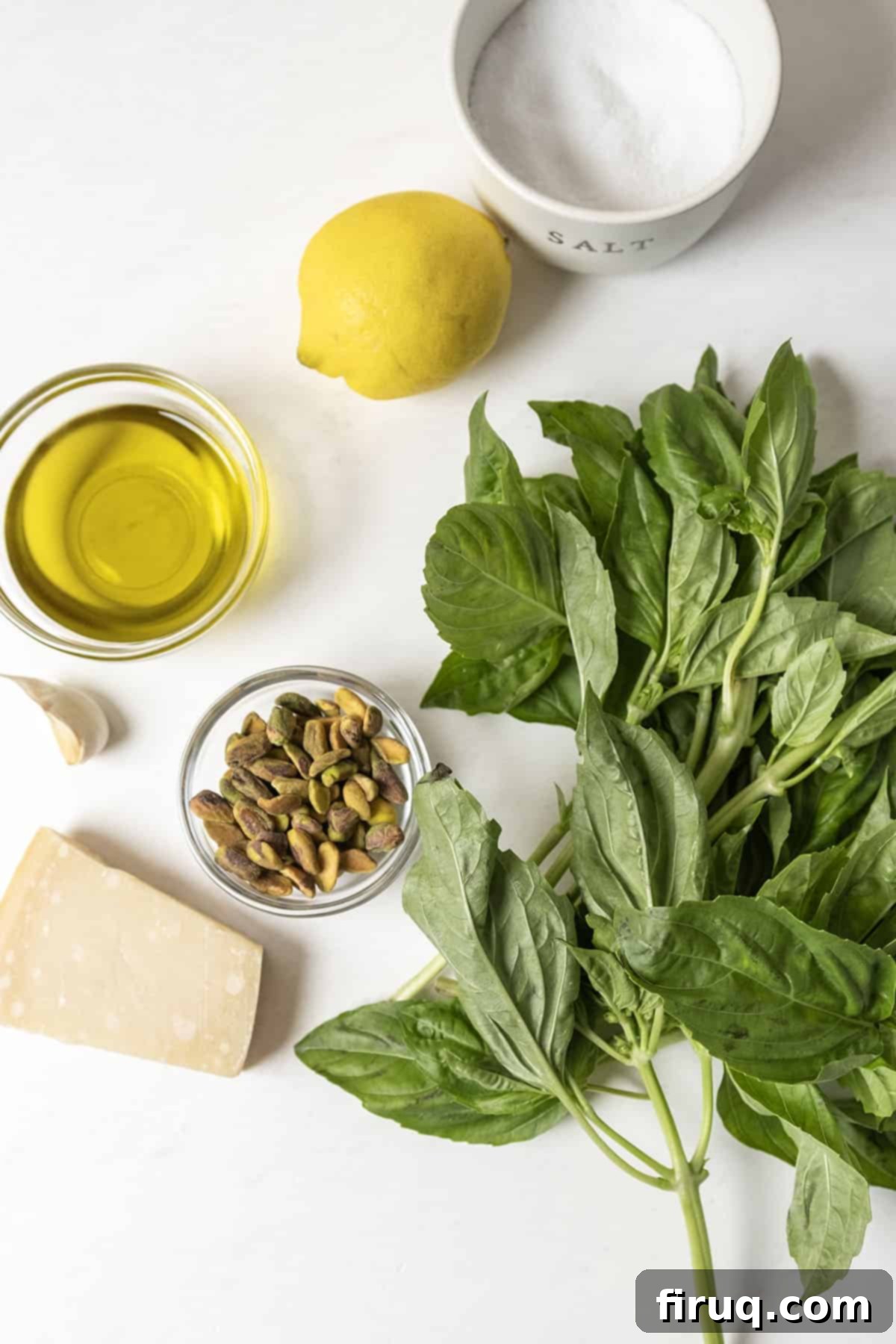
Pistachio Nuts. As the star of this recipe, we specifically call for shelled pistachio nuts, replacing the traditional pine nuts. This substitution works beautifully, yielding a pesto with a distinctively rich, slightly sweet, and earthy flavor. You can substitute pine nuts or even cashews at a 1:1 ratio if you prefer, but the unique sweetness of pistachios harmonizes wonderfully with fresh basil. For the best result, opt for raw, unsalted pistachios to control the sodium content and allow their natural flavor to shine through. If you can only find salted, reduce the added salt in the recipe accordingly.
Fresh Basil. The soul of any pesto is fresh basil. There’s no substitute for its aromatic, slightly peppery, and sweet notes. While two main types are commonly available, both will work well. Sweet basil, often found in grocery stores with larger, tender leaves, pairs exceptionally with the sweetness of pistachios. Genovese basil, characterized by its smaller, smoother, and often more intensely fragrant leaves, is also an excellent choice, offering a classic pesto flavor. Always choose fresh, vibrant green basil without any wilting or black spots.
Extra Virgin Olive Oil. Pesto is a celebration of simple, high-quality ingredients, and the olive oil is no exception. This isn’t the place to skimp! Only use a good quality, flavorful extra virgin olive oil. It forms the base of your pesto, contributing to its luscious texture and carrying the flavors of the other ingredients. A high-quality oil will ensure a smooth, rounded, and truly delicious pesto. The fruity and slightly peppery notes of a good EVOO are essential to the overall profile.
Garlic. Fresh garlic is paramount for a pungent, aromatic kick. While the recipe calls for one clove, feel free to adjust to your preference – some prefer a milder garlic note, while others enjoy a more robust flavor. Always use fresh cloves, never pre-minced jarred garlic, as it lacks the vibrant flavor needed for pesto.
Parmigiano-Reggiano. This hard, salty, and nutty Italian cheese is a non-negotiable for authentic pesto flavor. Freshly grated Parmigiano-Reggiano offers unparalleled depth. Avoid pre-grated cheeses, which often contain anti-caking agents that can affect the texture and flavor. For a slightly sharper, saltier profile, you can substitute a portion of Parmigiano-Reggiano with Pecorino Romano.
Lemon Juice. A squeeze of fresh lemon juice is not just for flavor; it also helps to preserve the vibrant green color of your pesto and prevents oxidation. It brightens the overall taste, cutting through the richness of the oil and nuts. Always use freshly squeezed lemon juice for the best results.
Salt. Fine sea salt or kosher salt is recommended. Start with the suggested amount and adjust to taste, especially if your pistachios or cheese are already salted.
*Please see the recipe card below for more information on exact ingredient quantities.
How to Make Pistachio Pesto: A Simple Guide
Making pistachio pesto is surprisingly quick and straightforward, especially with a food processor. Follow these steps to achieve a perfectly smooth and flavorful sauce:
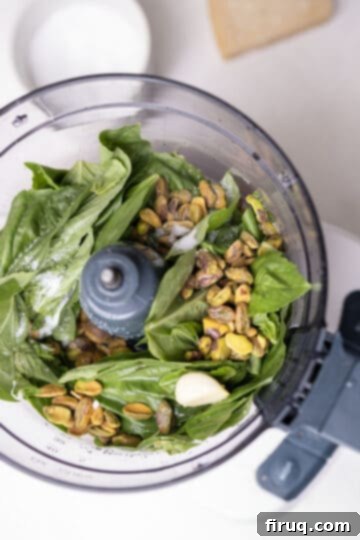
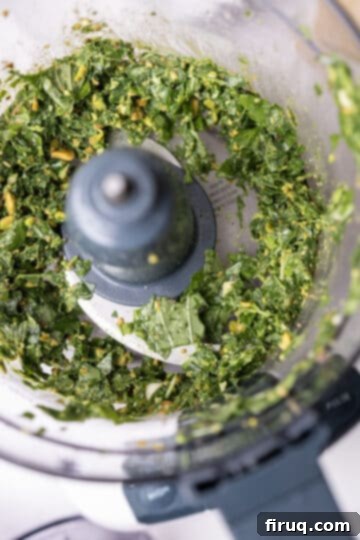

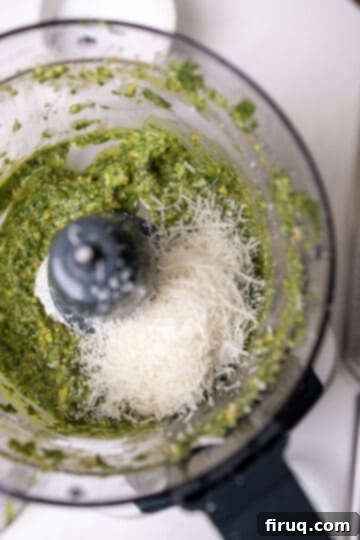
Pro-Tips for the Best Pistachio Pesto
Achieving pesto perfection is easier with a few insider tricks:
- Choose Shelled Pistachios: To save significant time and effort, always buy already peeled pistachios. Shelling pistachios can be tedious, and pre-shelled ones are readily available and equally delicious for this recipe. If you only have pistachios in their shells, blanching them briefly in hot water can help loosen the skins, but it’s an extra step.
- Achieving Desired Consistency: If you are looking to thin out the pesto for a saucier texture, make sure to add more extra virgin olive oil, and importantly, also incorporate a little more lemon juice. The lemon juice is crucial for balancing the richness of the oil and nuts, ensuring the flavor remains bright and tangy. Keep in mind, if you’re making it with pasta, you can always reserve and add a small amount of starchy pasta water directly to the pesto when tossing. This helps to emulsify the sauce and thin it out beautifully without diluting the flavor.
- For a Brighter Green Color: To help your basil retain its vibrant green hue and prevent oxidation (which can turn pesto brownish), briefly blanch the basil leaves in boiling water for 15-30 seconds, then immediately transfer them to an ice bath before drying thoroughly. While optional, this technique creates an even more stunningly green pesto.
- Toast Your Pistachios (Optional): For a deeper, more intense nutty flavor, lightly toast your raw pistachios in a dry pan over medium heat for 3-5 minutes, until fragrant. Be careful not to burn them! Let them cool completely before adding to the food processor. This step adds another layer of complexity to the pesto.
- The Food Processor vs. Mortar and Pestle: While a food processor makes quick work of pesto, a traditional mortar and pestle offers a more nuanced texture. The crushing action, rather than cutting, releases essential oils differently, often resulting in a richer aroma. If you have the time and equipment, it’s worth a try for a truly authentic experience, but the food processor is perfectly acceptable for daily use.
Recipe FAQs: All Your Pistachio Pesto Questions Answered
Got questions about making or storing your homemade pistachio pesto? We’ve got answers!
Yes, absolutely! Pesto freezes beautifully, making it an excellent sauce to prepare in larger batches. To freeze, transfer the pesto into an airtight container or a Ziploc bag, pressing out all the air before sealing. Alternatively, pour it into ice cube trays for convenient single-serving portions. Once frozen solid, transfer the cubes to a freezer-safe bag. It can be stored in the freezer for up to 6 months. To defrost, simply leave it out on the counter at room temperature for a few hours, or gently warm it in a bowl. Once defrosted, you might find it needs a little extra olive oil to restore its original creamy texture and a fresh squeeze of lemon juice to brighten the flavor before serving.
Yes, of course! That’s precisely what this recipe is designed for, offering a delightful alternative to traditional pine nut pesto. When substituting, anticipate a slightly different flavor profile. Pine nuts are generally more mild and buttery, whereas pistachios introduce a richer, earthier, and subtly sweeter taste that many find incredibly appealing. The texture can also be a bit creamier due to the natural oils in pistachios. Experiment to find your preferred nut!
Pesto can sometimes turn brown due to oxidation, which happens when the basil leaves are exposed to air. The lemon juice in the recipe helps to slow this process, but it can still occur, especially if stored improperly. To minimize browning, ensure your pesto is tightly sealed in an airtight container. For longer storage in the refrigerator, pour a thin layer of olive oil over the surface of the pesto before sealing. This creates a barrier against air, keeping it vibrantly green. Freezing also helps maintain its color.
Yes, you can easily make this pistachio pesto vegan! Simply omit the Parmigiano-Reggiano cheese. To maintain a similar savory, umami depth, you can add nutritional yeast to taste. You might also consider adding a pinch more salt to compensate for the saltiness of the cheese. The creamy texture will largely come from the pistachios and olive oil, so the absence of cheese won’t drastically alter the consistency.
Versatile Serving Suggestions for Pistachio Pesto
Pistachio pesto is an incredibly versatile condiment that can elevate a multitude of dishes with its unique flavor. Its creamy texture and rich, nutty notes make it the perfect addition to countless recipes, from simple weeknight meals to elegant entertaining options. Here are just a few ideas to inspire you:
- Pasta Perfection: The most classic way to enjoy pesto! Toss it with your favorite pasta shape – spaghetti, linguine, rotini, or orecchiette – for a quick and flavorful meal. Pistachio pesto can also be added to most red sauces, either stirred in as an enhancement or dolloped on top as a fresh, vibrant garnish. Try adding a little pesto to a creamy Creamy Red Pepper Sauce, a robust Sunday Sauce, or a simple Simple Pasta with Eggplant and Tomatoes for an added depth of flavor.
- Elevate Your Proteins: Pistachio pesto is fantastic with various meats and fish. Spoon some over your Authentic Italian Braciole or Cast Iron Chicken Breast for an instant burst of fresh flavor. You can also use it to stuff chicken breast, much like our delicious Pesto Stuffed Chicken, creating a moist and flavorful filling. It’s also excellent as a marinade or a vibrant accompaniment to grilled salmon or cod.
- Sensational Sandwiches and Spreads: Any sandwich would beg to have some pistachio pesto spread on the bread as a flavorful alternative to mayonnaise or mustard. It adds a gourmet touch and incredible depth to even the simplest sandwiches. Incorporate it into an Eggplant Parm Sandwich, a sophisticated Gruyere Grilled Cheese, or a rustic Peppers and Eggs Sandwich. It’s also wonderful as a dip for fresh vegetables or spread on crusty bread and crostini.
- Beyond the Obvious: Don’t limit your imagination! Pesto is a truly versatile topping and can be used in all sorts of dishes as an addition or even the main ingredient, like a rich Creamy Pesto Shrimp Pasta. Swirl it into scrambled eggs, drizzle it over roasted vegetables, mix it into salad dressings, or use it as a base for a gourmet pizza. Its bright, herbaceous, and nutty notes can transform everyday meals into extraordinary culinary experiences.
More Delicious Pesto Dishes to Explore
If you’ve fallen in love with the versatility of pesto, you’ll be delighted to know there are many more exciting pesto-based recipes to try. Expand your pesto repertoire with these fantastic dishes:
- Busiate with Pesto Trapanese
- Creamy Pesto Shrimp Pasta
- Lemon Pesto Spaghetti with Scallops
- Pesto Stuffed Chicken
We absolutely love hearing from you! Please leave a comment and a star rating below in the recipe card if you try our recipe. Your feedback is invaluable, and we enjoy knowing what you think of our culinary creations. Don’t forget to tag us on Instagram @vindelgiudice when you share your delicious pesto dishes!
📖 Recipe
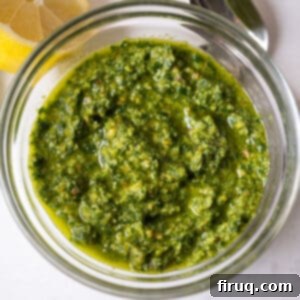
Pistachio Pesto
Vincent DelGiudice
Pin Recipe
Equipment
-
1 food processor
Ingredients
- 2 cups basil, packed
- ½ cup extra virgin olive oil
- 1 teaspoon salt
- 1 clove garlic
- 2 tablespoons fresh lemon juice
- ¼ cup raw shelled pistachios
- ¼ cup freshly grated Parmigiana-Reggiano cheese
Instructions
-
In the bowl of a food processor, combine the fresh basil leaves, garlic, salt, lemon juice, and shelled pistachios. Pulse several times until the basil is completely shredded and the mixture forms a coarse, slightly chunky paste. Scrape down the sides of the bowl as needed.
-
With the food processor running on low speed, slowly drizzle in the extra virgin olive oil through the feed tube. Continue processing until the pesto reaches your desired texture. Using ½ cup of olive oil will result in a creamy and thicker pesto. For a thinner consistency, add more olive oil and an extra splash of lemon juice to maintain flavor balance.
-
Finally, add the freshly grated Parmigiana-Reggiano cheese to the food processor. Pulse just a few times until the cheese is incorporated, being careful not to over-process. Taste and adjust seasoning with additional salt or lemon juice if desired. Serve immediately with pasta, spread on sandwiches, or use as a delicious accompaniment to your favorite dishes!
Notes
- Buy already peeled pistachios to save time. It’s much easier than trying to peel all of the shell off of a pistachio.
- If you are looking to thin out the pesto, make sure to add olive oil as well as a little more lemon juice to even out the flavor. Keep in mind, if you’re making with pasta, you can always add a little pasta water to thin out the pesto.
Nutrition
Carbohydrates: 14g
Protein: 17g
Fat: 129g
Saturated Fat: 21g
Polyunsaturated Fat: 16g
Monounsaturated Fat: 88g
Cholesterol: 17mg
Sodium: 2731mg
Potassium: 524mg
Fiber: 4g
Sugar: 3g
Vitamin A: 2857IU
Vitamin C: 23mg
Calcium: 423mg
Iron: 4mg
